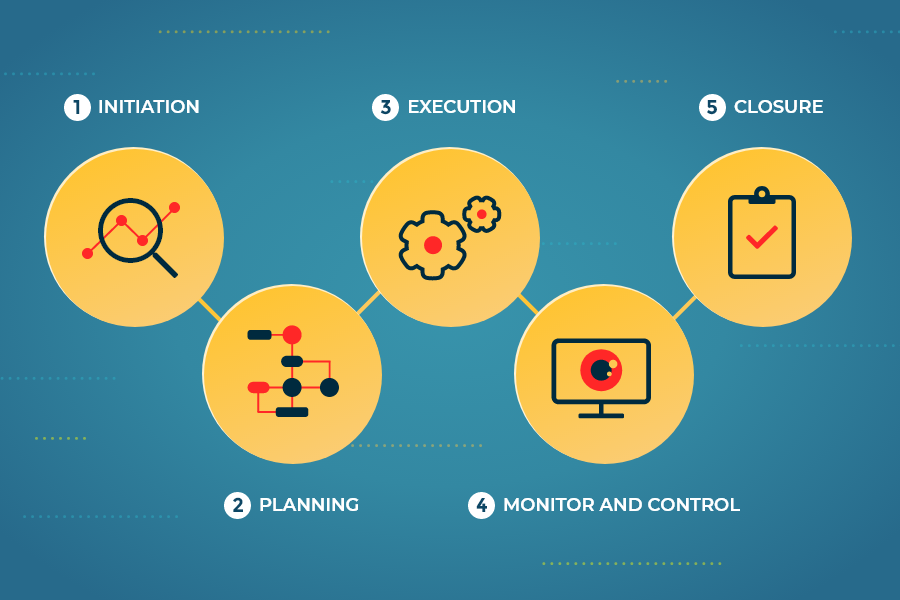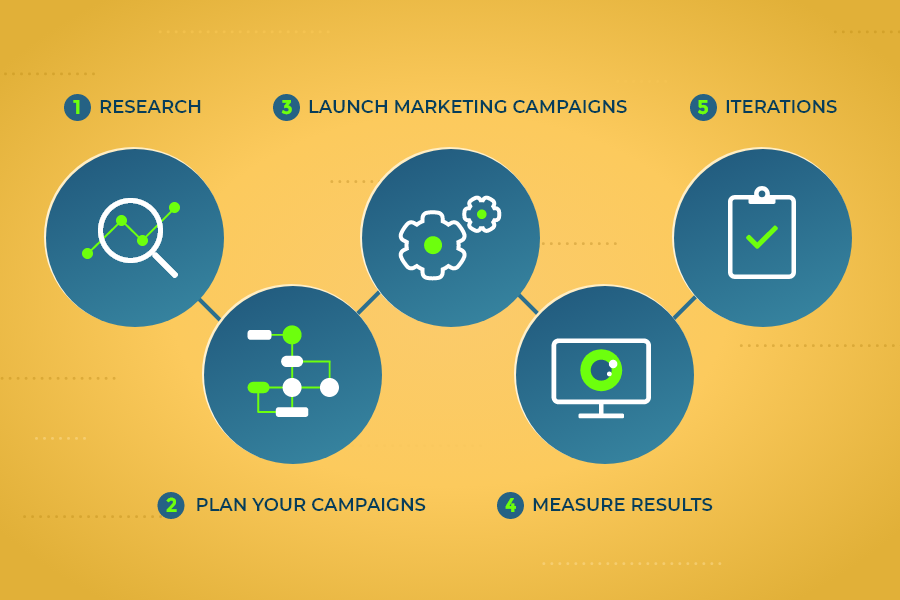
Marketing is exciting! Managing marketing projects may be challenging, but by using the right strategies you can be successful.
Marketing project management is another ball game as you need to keep your marketing campaigns aligned with your consumers’ preferences and industry trends.
Customer choices are frequently changing, resulting in changes to your marketing campaigns and ensuring they run on time. Here's where you need to have good project management in marketing.
Organizing your marketing project
Market research involves learning industry trends and identifying your target audience.
There are multiple teams involved such as:
- SEO professionals
- Subject matter experts
- Writers and editors
- Graphic designers
- Event planners
You can see there’s a lot of collaboration between various teams. You may have internal and external teams where some might be working from the office, whilst others are working remotely.
Read on: How Gantt charts help in different areas of project management.
Strategies to successfully manage your marketing projects
If you’re a marketing project manager, you need to have traits like flexibility and being able to adapt to changes. Handling multiple teams and dealing with external team members can be overwhelming unless you plan better.
Here are some tips on how to successfully manage your marketing projects:
1. Define your marketing goals
Your project needs clear business objectives. Marketing projects are fast-paced, and you may need to adapt to changes. Defining goals helps you measure the success of your project over time.
You can define goals like:
- Increase market share of your product
- Increase website traffic
- Gain more social media followers
- Grow an email list
- Increase brand awareness
2. Adapt to the marketing project management process
A typical project management process is:
- Initiation – Define the scope
- Planning – Content creation and resourcing
- Execution – Developing content
- Monitor and control – Optimize and identify risks and roadblocks
- Closure – Get the required approval, publish and review

In the same manner, marketing projects have a few stages:
- Research – Research market data, industry trends, customer preferences, and other required relevant data
- Plan your campaigns – The project manager, sales, and other teams prepare goals and a project roadmap
- Launch marketing campaigns – As per the project plan and goals defined, the campaigns get launched
- Measure results – Review the performance of campaigns and results of marketing metrics and A/B testing
- Iterations – In this stage, campaigns are optimized based on performance

3. Opt for an agile approach
Agile project management helps deliver projects in smaller pieces for a shorter period, like a week or two. The iteration is called a sprint.
The agile approach is suitable for marketing projects. Using agile boards with lists like To-do, In-Progress, and Done, means projects can be moved across and allows work to be done in iterative sprints. An agile approach makes it faster for teams to deliver changes by seeing how campaigns are performing. Using the right project management tool provides your team with more agility.
Read on: Going agile with Vault.
4. Maintain an idea backlog
Marketing involves coming up with plenty of creative ideas in order to beat the competition. It would be good to maintain a backlog of ideas where your teams can generate and contribute ideas to the idea backlog. You can leave the backlog open so people can contribute ideas anytime or analyze the ideas.
Ideas can be used at the right time and can help develop winning strategies.
5. Involve teams in your project planning
Marketing projects involve a lot of cross-functional and inter-team collaboration. Team members know their strengths and can set realistic timelines to deliver quality work. Having more realistic timelines will improve the success of your projects.
6. Use an automated project management tool
Spreadsheets and emails build silos of information. Today's projects need a collaborative approach where communication must be seamless, there’s clear visibility of information across the organization, and real-time updates are always available as they help make timely decisions.
You can use Vault for project management. Vault has agile boards that help with marketing projects. A KPI dashboard shows real-time relevant metrics and is customizable as per project. Assign tasks and monitor the task status – completed, on hold, delayed, etc. Notifications and reminders appear on the dashboard so that everyone is on the same page and knows what to do.
Vault lets you plan and execute marketing projects, as well as coordinate with multiple teams seamlessly. Information is available centrally and can be shared across teams or people of your choice. Vault empowers your employees to stay connected and share work files. Project managers are also able to view critical metrics by using the KPI dashboard.
Read on: Have you properly defined your KPIs to your best advantage?
What does a marketing project manager do?
The role of a marketing project manager is to promote company’s products and services and raise brand awareness with the goal to drive sales. The MPM will evaluate current marketing strategies and activities based on their outcome and implement new approaches if necessary. The responsibility of a MPM is to define the scope of a marketing project and its goal, calculate budget, delegate marketing tasks, set the project timeline and oversee all stages of a marketing initiative.
What is a marketing PMO?
A marketing PMO (project management office) is a team of marketing specialists who work at an organizational level. They coordinate a number of projects and support marketing project managers. The PMO analyzes and validates projects metrics, and ensures best practices are maintained and project statuses documented. The PMO understands KPIs tied to marketing projects and will ensure projects targets are met. Whether your organization needs a PMO or not will depend on your organization size and the number of marketing projects you have. If marketing is your industry, you would certainly benefit from appointing a PMO.
Project management for marketing
If you wonder whether you need project management for marketing, ask yourself whether you will have the right people for the right task at the right time, and whether you can track your budget and project timeline effectively.
Project management for marketing agencies
There are many providers offering project management tools for agencies which allow you to consolidate data for variety of projects in one place, such as Slenke, Productive, or Vault ERP. They all have different features to meet your specific needs. When choosing the right solution for your business ,consider your size, number of projects and your budget.
Project management for marketing departments
As you can see, marketing projects are executed in multiple phases and involve a large volume of tasks. To coordinate all marketing activities, the project marketing manager or coordinator uses project management tools to ensure a campaign’s success. It will give marketing departments the tools to plan, allocate and track tasks and provide valuable metrics to measure actual results against set targets.
What are marketing project deliverables?
Deliverables (any output during marketing project stages) can be internal, external, process or product related. These categories can all overlap at times.
Deliverables are not to be confused with milestones (project progress markers) which break a project into bite-size phases and are completed by set deadlines. Multiple deliverables can be executed within a milestone. Deliverables in marketing projects can have dependencies like in any other projects.
Marketing deliverables during the process
Marketing process deliverables are initial outputs that move a project further without directly fulfilling a project requirement. They can be internal or external. In practical terms, this means when you design something like a media graphic, for example, this would be a marketing process deliverable. When the graphic is printed or published, it will become a marketing product deliverable.
Internal marketing process deliverables are concerned with the multi-disciplinary team workflow, whereas external marketing process deliverables require the input of stakeholders or clients, such as in the initial design approval. Proofreading of a blog article is a marketing process deliverable, while publishing it would make it marketing product deliverable.
Content marketing deliverables
Content marketing deliverables are commonly scheduled and tracked using project management tools. Although they will differ from project to project, the content deliverables are commonly produced in stages:
- Content Research – Includes competitor analysis, identifying keywords to maximize your content exposure, researching what your target audience want, industry trends etc.
- Content Strategy – The results of your content research will help build a content strategy. The strategy will make it clear what are you trying to achieve, how and when. At this stage you should decide where you want the marketing content to be seen your website (Instagram, LinkedIn, a newsletter, YouTube, etc.). The content strategy should be agile to allow for requirement changes. Your client might come up with a new idea, or you will experience sudden changes in consumer behavior or trends.
- Content Creation – The most time consuming and impactful phase of a marketing project. The deliverables here can take a variety of shapes such as a blog article, video content, a photo shoot, a podcast, social media posts etc.
- Content Marketing – The created content is published across social media channels or distributed as per your content strategy.
- Content Reporting – This gives you an overview of how your content is performing. Google Analytics is a great (and free) tool to measure page views, bounce rate and the average time on a page. Analyze your metrics and if the bounce rate is high, it might be good to reconsider your strategy.
Brand strategy deliverables
Brand strategy deliverables are not easy to map. As a brand strategist, you will have to master many unknows and obstacles, bypass competitors, and do a lot (and we mean a lot) of research until you can let your creativity loose and come up with a brand strategy plan.
The two most important brand strategy deliverables are:
- Brand strategy – Includes all strategic branding elements, which define the expression of the brand, such as: internal brand, brand purpose, brand vision, brand values, audience persona, storytelling framework, brand strategy guidelines and more.
- Brand visuals – Includes the logo, typography, color palette, image style, channel analysis, marketing plan, artwork, ad placement, iconography, style guide, digital and physical collateral deliverables, and others.
Performance marketing deliverables
Performance marketing is growing exponentially. It is a type of digital marketing where brands pay Google, Bing or other platforms only when specific actions are completed such as click, sale or lead. Sponsor content, affiliate marketing and SEM (search engine marketing) are typically used methods, all based on strong keywords to attract your audience. The bonus of performance marketing is that budget is spent only on a successful campaign.
The deliverables in performance marketing are the same as in any other types of marketing: posting content on social media channels, web page, YouTube videos, etc.
Try Vault ERP for marketing project management
A high level of flexibility and easy customization makes Vault ideal for marketing project management.
Discover how to easily manage your marketing projects! Schedule a free consultation today.
